Ards prone position - Study guides, Class notes & Summaries
Looking for the best study guides, study notes and summaries about Ards prone position? On this page you'll find 344 study documents about Ards prone position.
Page 4 out of 344 results
Sort by
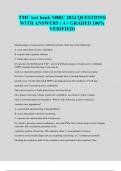
-
TMC test bank NBRC 2024 QUESTIONS WITH ANSWERS ( A+ GRADED 100% VERIFIED)
- Exam (elaborations) • 127 pages • 2024
-
- $16.49
- + learn more
TMC test bank NBRC 2024 QUESTIONS WITH ANSWERS ( A+ GRADED 100% VERIFIED) Disadvantages of noninvasive ventilation include which one of the following? A. costs more than invasive ventilation B. requires heavy patient sedation C. limits direct access to lower airway D. increases the likelihood of VAP - answerDisadvantages of noninvasive ventilation (NPPV) include the following: it can only be used in cooperative patients; it does not provide direct airway access (thus increasing the ris...

-
NBRC KETTERING SEMINARS - THERAPEUTIC PROCEDURES EXAM QUESTIONS WITH COMPLETE SOLUTIONS VERIFIED GRADED A+
- Exam (elaborations) • 14 pages • 2024
-
Available in package deal
-
- $8.99
- + learn more
NBRC KETTERING SEMINARS - THERAPEUTIC PROCEDURES EXAM QUESTIONS WITH COMPLETE SOLUTIONS VERIFIED GRADED A+ Describe the ideal breathing pattern for improving ventilation regardless of the type of therapy being administered. slow, deep inspiration, inspiratory pause (1 - 3 seconds), exhalation is slow, passive and relaxed, relaxed with normal tidal volume breathing. Describe how a patient should be positioned to enhance oxygenation with the following pathologies: CHF, Obesity, ARDS, and Unil...

-
Critical Care exam 1: Respiratory Practice Questions and Answers. (Graded A)
- Exam (elaborations) • 19 pages • 2023
- Available in package deal
-
- $10.89
- + learn more
1) A nurse is caring for a patient with ARDS. The nurse views the ABG. What value should the nurse report to the physician? pH: 7.35 PaCO2: 26mmhg PaO2:95 HCO3: 22 a) PaCO2 b)pH c)HCO3 d)PaO2 - ANSWER-a The normal range for PaCO2 is 35-45. This patient is experiencing a superimposed respiratory alkalosis likely due to hyperventilation. The nurse should report the PaCO2 to the physician. 2) A nurse must position the patient prone after his diagnosis of acute respiratory distress...
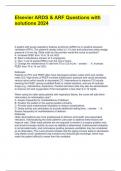
-
Elsevier ARDS & ARF Questions with solutions 2024
- Exam (elaborations) • 6 pages • 2024
-
Available in package deal
-
- $14.99
- + learn more
Elsevier ARDS & ARF Questions with solutions 2024 A patient with acute respiratory distress syndrome (ARDS) is on positive pressure ventilation (PPV). The patient's cardiac index is 1.4 L/min and pulmonary artery wedge pressure is 8 mm Hg. What order by the provider would the nurse to question? A. Increase PEEP from 10 to 15 cm H2O. B. Start a dobutamine infusion at 3 mcg/kg/min. C. Give 1 unit of packed RBCs over the next 2 hours. D. Change the maintenance IV rate from 75 to 125 mL/hr. A...
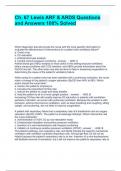
-
Ch. 67 Lewis ARF & ARDS Questions and Answers 100% Solved
- Exam (elaborations) • 8 pages • 2024
-
Available in package deal
-
- $16.99
- + learn more
Ch. 67 Lewis ARF & ARDS Questions and Answers 100% Solved Which diagnostic test will provide the nurse with the most specific information to evaluate the effectiveness of interventions for a patient with ventilatory failure? a. Chest x-ray b. O2 saturation c. Arterial blood gas analysis d. Central venous pressure monitoring ANS: C Arterial blood gas (ABG) analysis is most useful in this setting because ventilatory failure causes problems with CO2 retention, and ABGs provide information ab...
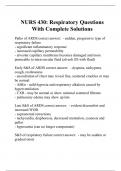
-
NURS 430: Respiratory Questions With Complete Solutions
- Exam (elaborations) • 10 pages • 2023
-
Available in package deal
-
- $10.49
- + learn more
Patho of ARDS correct answer: - sudden, progressive type of respiratory failure - significant inflammatory response - increased capillary permeability - alveolar capillary membrane becomes damaged and more permeable to intravascular fluid (alveoli fill with fluid) Early S&S of ARDS correct answer: - dyspnea, tachypnea, cough, restlessness - auscultation of chest may reveal fine, scattered crackles or may be normal - ABGs - mild hypoxia and respiratory alkalosis caused by hyperventilati...

-
ATI Respiratory Test bank Questions & Answers
- Exam (elaborations) • 13 pages • 2024
-
Available in package deal
-
- $10.64
- + learn more
ATI Respiratory Test bank Questions & Answers-1. A perioperative nurse is caring for a postoperative client. The client has a shallow respiratory pattern and is reluctant to cough or to begin mobilizing. The nurse should address the client's increased risk for what complication? A. Acute respiratory distress syndrome (ARDS) B. Atelectasis C. Aspiration D. Pulmonary embolism - B. Atelectasis 2. The nurse is providing client teaching to a young parent who has brought their 3-month-old infa...
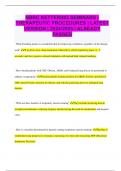
-
NBRC KETTERING SEMINARS - THERAPEUTIC PROCEDURES | LATEST VERSION | 2024/2025 | ALREADY PASSED
- Exam (elaborations) • 25 pages • 2024
-
Available in package deal
-
- $10.32
- + learn more
NBRC KETTERING SEMINARS - THERAPEUTIC PROCEDURES | LATEST VERSION | 2024/2025 | ALREADY PASSED - What breathing pattern is considered ideal for improving ventilation, regardless of the therapy used? It involves slow, deep inspiration, followed by a brief inspiratory pause (1 - 3 seconds), and slow, passive, relaxed exhalation with normal tidal volume breathing. - How should patients with CHF, Obesity, ARDS, and Unilateral lung disease be positioned to enhance oxygenation? Position ...
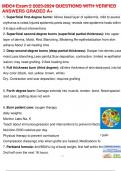
-
MDC4 Exam 2 2023-2024 QUESTIONS WITH VERIFIED ANSWERS GRADED A+
- Exam (elaborations) • 19 pages • 2023
-
- $13.49
- + learn more
1. Superficial first-degree burns: Above basal layer of epidermis, mild to severe erythema is noted,Injured epidermis peels away; reveals new epidermis heals within 3-6 days without interventions 2. Superficial second-degree burns (superficial partial-thickness): Into upper layer of dermis, Moist, Red, Blanching, Blistering,Re-epithelialization from skin adnexa About 2 wk healing time 3. Deep second-degree burns (deep partial-thickness): Deeper into dermis,Less moist,Less blanching,Less painfu...
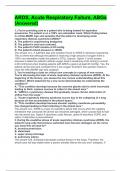
-
ARDS, Acute Respiratory Failure, ABGs (Answered)
- Exam (elaborations) • 11 pages • 2024
-
- $10.98
- + learn more
ARDS, Acute Respiratory Failure, ABGs (Answered) 1.) You're providing care to a patient who is being treated for aspiration pneumonia. The patient is on a 100% non-rebreather mask. Which finding below is a HALLMARK sign and symptom that the patient is developing acute respiratory distress syndrome (ARDS)?* A. The patient is experiencing bradypnea. B. The patient is tired and confused. C. The patient's PaO2 remains at 45 mmHg. D. The patient's blood pressure is 180/96. The answer is C....

How much did you already spend on Stuvia? Imagine there are plenty more of you out there paying for study notes, but this time YOU are the seller. Ka-ching! Discover all about earning on Stuvia


